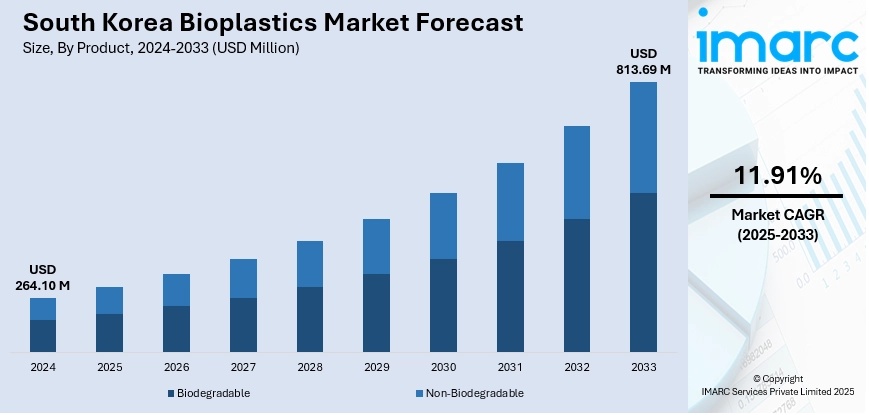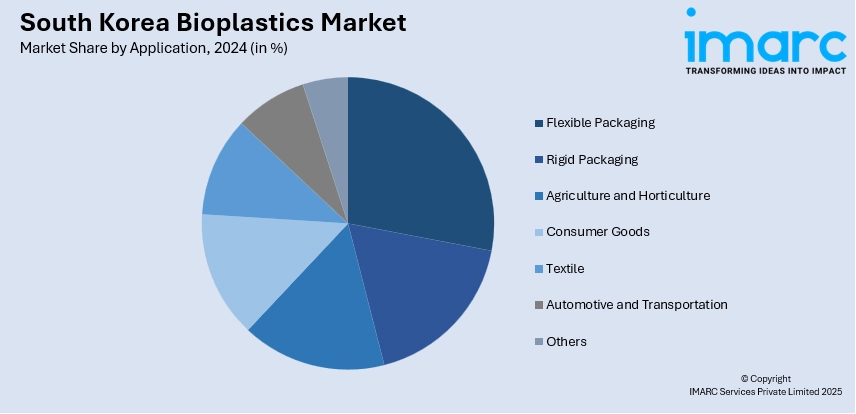
South Korea Bioplastics Market Size, Share, Trends and Forecast by Product, Application, Distribution Channel, and Region, 2025-2033
South Korea Bioplastics Market Overview:
The South Korea bioplastics market size reached USD 264.10 Million in 2024. Looking forward, the market is projected to reach USD 813.69 Million by 2033, exhibiting a growth rate (CAGR) of 11.91% during 2025-2033. The market is driven by regulatory frameworks targeting plastic waste reduction, along with enforced procurement of sustainable materials. Breakthroughs in material innovations and widespread integration of local production enhance performance and price competitiveness. Corporate and consumer sustainability commitments are further augmenting the South Korea bioplastics market share.
|
Report Attribute
|
Key Statistics
|
|---|---|
|
Base Year
|
2024
|
|
Forecast Years
|
2025-2033
|
|
Historical Years
|
2019-2024
|
| Market Size in 2024 | USD 264.10 Million |
| Market Forecast in 2033 | USD 813.69 Million |
| Market Growth Rate 2025-2033 | 11.91% |
South Korea Bioplastics Market Trends:
Regulatory Mandates and Circular Economy Policies
South Korea has set ambitious targets for reducing plastic waste and promoting recyclable materials across industries, reflecting national commitments to circular economy principles and zero-waste objectives. Legislation such as extended producer responsibility (EPR), single-use plastic bans, and eco-labelling requirements have pushed manufacturers and retailers to seek viable alternatives. This policy environment has accelerated the adoption of bioplastic solutions in product categories from packaging to consumer goods. For instance, on February 18, 2025, SK Chemicals announced it will establish a Recycle Innovation Center (RIC) at its Ulsan plant, marking its first depolymerization-based plastic recycling facility in South Korea. The center will include a pilot depolymerization plant capable of producing 50 tons of r-BHET annually, aimed at recycling low-quality plastics including textiles, films, and automotive parts. Regulatory compliance incentives and procurement preferences further encourage R&D investments and industrial-scale biopolymer production. By aligning upstream material innovation with downstream waste management strategies, this framework supports sustainable material cycles. These coordinated efforts across government, industry, and waste infrastructure underpin South Korea bioplastics market growth.

To get more information on this market, Request Sample
Advances in Material Innovation and Local Production
South Korea’s chemical and biotech industries are investing in next-generation bioplastic technologies to overcome traditional limitations in cost, performance, and scalability. Local producers are developing custom bio-based resins, such as PLA, PHA, and PBS, with improved properties like heat resistance, durability, and biodegradability. On March 31, 2023, TotalEnergies Corbion, POSCO International, and ESOL announced a strategic partnership to advance polylactic acid (PLA) recycling infrastructure and technology in South Korea. POSCO International will finance the project, ESOL will manage PLA waste collection and processing, and TotalEnergies Corbion will contribute its expertise in advanced PLA recycling. With the PLA market growing at over 20% annually, this collaboration supports South Korea’s bioplastics sector by strengthening its circular economy framework and low-carbon materials strategy. Partnerships between academic institutions and industry have enabled pilot plants and commercialization pathways, while vertical integration from feedstock production to resin compounding has strengthened supply chain resilience. These developments are crucial to meeting the diverse needs of fast-moving consumer goods, electronics, and automotive sectors. Investments in process innovation, feedstock diversification (including cellulose and biomass residues), and production optimization are steadily lowering costs, narrowing the premium gap with petrochemical plastics. As these capabilities mature, bioplastics are moving from niche to mainstream use cases.
South Korea Bioplastics Market Segmentation:
IMARC Group provides an analysis of the key trends in each segment of the market, along with forecasts at the country and regional levels for 2025-2033. Our report has categorized the market based on product, application, and distribution channel.
Product Insights:
- Biodegradable
- Polylactic Acid
- Starch Blends
- Polybutylene Adipate Terephthalate (PBAT)
- Polybutylene Succinate (PBS)
- Others
- Non-Biodegradable
- Polyethylene
- Polyethylene Terephthalate
- Polyamide
- Polytrimethylene Terephthalate
- Others
The report has provided a detailed breakup and analysis of the market based on the product. This includes biodegradable (polylactic acid, starch blends, polybutylene adipate terephthalate (PBAT), polybutylene succinate (PBS), and others) and non-biodegradable (polyethylene, polyethylene terephthalate, polyamide, polytrimethylene terephthalate, and others).
Application Insights:

- Flexible Packaging
- Rigid Packaging
- Agriculture and Horticulture
- Consumer Goods
- Textile
- Automotive and Transportation
- Others
The report has provided a detailed breakup and analysis of the market based on the application. This includes flexible packaging, rigid packaging, agriculture and horticulture, consumer goods, textile, automotive and transportation, and others.
Distribution Channel Insights:
- Online
- Offline
The report has provided a detailed breakup and analysis of the market based on the distribution channel. This includes online and offline.
Regional Insights:
- Seoul Capital Area
- Yeongnam (Southeastern Region)
- Honam (Southwestern Region)
- Hoseo (Central Region)
- Others
The report has also provided a comprehensive analysis of all major regional markets. This includes Seoul Capital Area, Yeongnam (Southeastern Region), Honam (Southwestern Region), Hoseo (Central Region), and others.
Competitive Landscape:
The market research report has also provided a comprehensive analysis of the competitive landscape. Competitive analysis such as market structure, key player positioning, top winning strategies, competitive dashboard, and company evaluation quadrant has been covered in the report. Also, detailed profiles of all major companies have been provided.
South Korea Bioplastics Market Report Coverage:
| Report Features | Details |
|---|---|
| Base Year of the Analysis | 2024 |
| Historical Period | 2019-2024 |
| Forecast Period | 2025-2033 |
| Units | Million USD |
| Scope of the Report |
Exploration of Historical Trends and Market Outlook, Industry Catalysts and Challenges, Segment-Wise Historical and Future Market Assessment:
|
| Products Covered |
|
| Applications Covered | Flexible Packaging, Rigid Packaging, Agriculture and Horticulture, Consumer Goods, Textile, Automotive and Transportation, Others |
| Distribution Channels Covered | Online, Offline |
| Regions Covered | Seoul Capital Area, Yeongnam (Southeastern Region), Honam (Southwestern Region), Hoseo (Central Region), Others |
| Customization Scope | 10% Free Customization |
| Post-Sale Analyst Support | 10-12 Weeks |
| Delivery Format | PDF and Excel through Email (We can also provide the editable version of the report in PPT/Word format on special request) |
Key Questions Answered in This Report:
- How has the South Korea bioplastics market performed so far and how will it perform in the coming years?
- What is the breakup of the South Korea bioplastics market on the basis of product?
- What is the breakup of the South Korea bioplastics market on the basis of application?
- What is the breakup of the South Korea bioplastics market on the basis of distribution channel?
- What is the breakup of the South Korea bioplastics market on the basis of region?
- What are the various stages in the value chain of the South Korea bioplastics market?
- What are the key driving factors and challenges in the South Korea bioplastics market?
- What is the structure of the South Korea bioplastics market and who are the key players?
- What is the degree of competition in the South Korea bioplastics market?
Key Benefits for Stakeholders:
- IMARC’s industry report offers a comprehensive quantitative analysis of various market segments, historical and current market trends, market forecasts, and dynamics of the South Korea bioplastics market from 2019-2033.
- The research report provides the latest information on the market drivers, challenges, and opportunities in the South Korea bioplastics market.
- Porter's five forces analysis assist stakeholders in assessing the impact of new entrants, competitive rivalry, supplier power, buyer power, and the threat of substitution. It helps stakeholders to analyze the level of competition within the South Korea bioplastics industry and its attractiveness.
- Competitive landscape allows stakeholders to understand their competitive environment and provides an insight into the current positions of key players in the market.
Need more help?
- Speak to our experienced analysts for insights on the current market scenarios.
- Include additional segments and countries to customize the report as per your requirement.
- Gain an unparalleled competitive advantage in your domain by understanding how to utilize the report and positively impacting your operations and revenue.
- For further assistance, please connect with our analysts.
 Request Customization
Request Customization
 Speak to an Analyst
Speak to an Analyst
 Request Brochure
Request Brochure
 Inquire Before Buying
Inquire Before Buying




.webp)




.webp)












